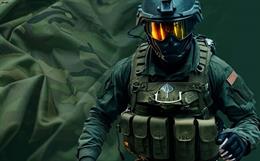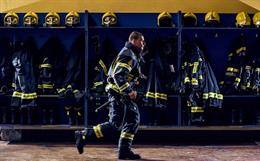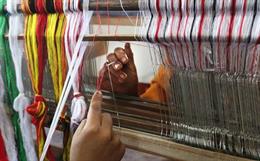"Jerry McGee is an Oklahoma pipeline field foreman. Onwhat started out as a routine workday, Jerry set off alone to inspect abroken-down pump motor. The motor's fuse had blown and had caused the uppersection of the starter-motor to burn. In need of a fire extinguisher, Jerry proceeded to shut the cabinet door. As he did so an arc flashed out, blowing the door open andknocking Jerry clear across the building. Jerry received second and thirddegree burns to his hands and the face, but coverall he was wearing prevented injuries to other parts of the body, including his wrists, which were covered by theoveralls cuffs. Had he been wearing standard apparel which cant easilyignite, Jerrys story may have been very different."
"Engineered Garments"
Thirty years ago, scientists from E.I. DuPont de Nemours andCompany created fibers for firefighter's protective clothing known as Nomex andKevlar. The aramids inherent flame-resistant properties make it ideal for themanufacture of fireproof clothing. Kevlar is a para-aramid organic fiberconsisting of long highly oriented molecular chains produce frompoly-paraphenylene terephthalamide (DuPont). The highly oriented chains withstrong inter-chain bonding which result in a unique combination of properties, including: high tensile strength at low weight, low elongation to break highmodulus, low electrical conductivity, high chemical resistance, low thermalshrinkage, high toughness, excellent dimensional stability, high cutresistance, flame resistance and self-extinguishing.
The Need of Protection
Protections from heat, flame, molten-metal splashes, severecold and frost, radiation source, etc. are prime requirement for both civil anddefense applications. There are various risks, which require proper protectionof the human body in order to minimize the damage, both at physiological andpsychological level. Thermal risks in fire situations against which human skinhas to be protected may be due to:
- Flames (convective heat)
- Contact from hot solid objects (conduction heat).
- High radiant temperature from localized source or from all around (Radiant heat).
- Sparks, drops of molten metal, hot gases and vapors.
Human tissue is very sensitive to temperature. When humantissue is exposed to any of the above hazards, the body experiences pain/second-degree/ third degree burn. Total heat energy as low as 0.64 cal/cm2(26.8 kJ/m2), results in a sensation of pain, and 1.2 cal/cm2(50.2 kJ/m2) causes second-degree burns on exposed tissues. At 45 0C,the sensation of pain is experienced, and at 72 0C the skin iscompletely burnt. The mode of transfer establishes the means by which protection should be achieved. The rate of heat transfer is measured in terms of heat flux,which is the quantity of heat passing through unit area per second; it is expressed in kW/m2. The measured heat flux determines the level of protection required. In order to achieve thermal protection the protective fabric/ clothingshould meet the following requirements.
- Flame-resistance
- Integrity
- Insulation
- Liquid-repellency
Combustion and Prevention Mechanism of Fiber:
The effect of heat on a fibre can produce a physical as well as a chemical change. In order to understand the protective function of the fabric and the garment, it is essential to understand the combustion mechanism of the fibre. A preventive step can be decided only after understanding the mechanism of combustion of fibre.
Textile combustion is a complex phenomenon that involves heating, decomposition leading to gasification, ignition, and flame propagation. The rate of the initial rises in temperature depends on the fiber specific heat, thermal conductivity, latent heat of fusion, vaporization or other enthalpy changes that occur during the combustion. In thermoplastic fibers, the physical changes are at second-order transition and subsequently melting occurs at a melting temperature, whereas chemical changes take place at temperature where thermal degradation (pyrolysis) occurs and the temperature where subsequent oxidation and combustion may occur. The Different thermal propertied of different fiber listed in Table 1. Fibers undergo combustion when exposed to heat either directly or via the route of pyrolysis (Tp)-oxidation-combustion (Tc) as indicated in the Fig 1.
Table 1 Thermal Transition Temperatures of Fibers:
|
Fibre |
Tg (0C) (Softens) |
Tm (0C) (Melts) |
Tp (0C) (Pyrolysis) |
Tc (0C) (Combustion) |
DH (kJ/g) |
|
|
Wool |
- |
- |
245 |
600 |
27 |
25.0 |
|
Cotton |
- |
- |
350 |
350 |
19 |
18.4 |
|
Viscose |
- |
- |
350 |
420 |
19 |
18.9 |
|
Triacetate |
172 |
290 |
305 |
540 |
- |
18.4 |
|
Nylon 6 |
50 |
215 |
431 |
450 |
39 |
20.0-21.5 |
|
Nylon 6.6 |
50 |
265 |
403 |
530 |
32 |
20-21 |
|
Polyester |
80-90 |
255 |
420-477 |
480 |
24 |
20-21.5 |
|
Acrylic |
100 |
>220 |
290 |
>250 |
32 |
18.2 |
|
Polypropylene |
-20 |
165 |
469 |
550 |
44 |
18.6 |
|
Modacrylic |
<80 |
>240 |
273 |
690 |
- |
29-30 |
|
PVC |
<80 |
>180 |
>180 |
450 |
21 |
37-39 |
|
PVDC |
-17 |
180-210 |
>220 |
532 |
11 |
60.0 |
|
PTFE |
126 |
>327 |
400 |
560 |
4 |
95.0 |
|
Oxidized acrylic |
>640 |
- |
55 |
- |
- |
- |
|
Nomex |
275 |
375 |
310 |
500 |
30 |
28.5-30 |
|
Kevlar |
340 |
560 |
590 |
>550 |
- |
29 |
|
PBI |
>400 |
- |
>500 |
>500 |
- |
40-42 |
* LOI: Limiting-oxygen index.
Four ways of prevention of combustion have been suggested as follows:
- By treating the material with heat-absorbing products.
- The increase in pyrolysis temperature makes the material heat-resistant.
- The third way of stopping combustion is to prevent evaporation, that is, to form non-volatile compounds in situ, called char.
- Eliminating the oxygen from the combustion zone and thus stopping oxidation may prevent combustion.
The Effect of Fiber / Fabric Construction:
The flame resistance / retardance of the textile material depends on the fibre nature, fabric/yarns structure and fabric composition. The nature of the fibre decides its inherent tendency and ease of burning whereas fabric composition shows different type of such constituents and gives an indication of the burning behavior. The structure of yarn and fabric decides the rate of burning and fabric construction, with the fabric weight plays an important an important role in deciding the suitability for different work wear applications as listed below.
- For a hot environment in which the fire hazard is principally a direct flame, a lightweight tightly woven construction such as 150-200 GSM flame retardant cotton sateen, would be most suitable
- For the full installations, a flame-retardant cotton drill of about 250-320 GSM is recommended. for a workshop in which the garment is subjected to a continuous shower of sparks and hot fragments as well as a risk of direct flame, a heavier fabric is required and a raised twill or velveteen of about 320-400 g/sq. mt in FR cotton could be chosen.
- Moreover, with molten metal splashes, the protection of the wearer against the heat flux resulting from the impact is also important. In such cases, fabric masses upto 900 GSM are found useful.
Performance Garment for Fire Fighter:
The primary goal of any performance garment system is to eliminate/ minimize the risk due to hostile environment, regardless of the location. In case of fire fighting, the immediate reflex action is to control an emergency as quickly as possible and at the same time take steps to minimize eventual damage to and loss of materials and persons. The objectives of a fire fighter reaching an incident are to:
- Save life and to prevent/ minimize injury,
- Prevent / minimize damage to property
- Prevent or minimize damage to the environment.
The role of the fire fighters' personal protective clothing is not only to protect the fire fighter but also to enable the fire fighter to achieve above mentioned objectives. The type of protective garments and the protection it offers are selected on the basis on the degree of risk involved; fire-fighting protective garments are classified as:
- Protective garments for structural fire fighting.
- Proximity fire fighting garments.
- Fire Entry suits.
- Station/ work uniforms.
Fig 2 shows garments are used at different levels and in different applications depending upon the modes of heat transfer and hazards involved in combating the hostile environment.
Fig 2: Fire-fighting protective garments
Protective Garments for structural Fire Fighter:
The activities of rescue, fire suppression, and property conservation in buildings, enclosed structures, vehicles, and vessels or like properties that are involved in a fire or emergency situation are termed as Structural Fire Fighting. Various municipal fire brigades require protective clothing for fire fighting.
Fig 3.Conventional Fire Fighter Suit
All protective garments for structural fire-fighting operations must meet the garment element requirements of NFPA 1971 in North America and EN 469 in European Union. Protective garments are the coat (standard length-35"), trouser (standard length-26", 28", 30", 32"), or coverall elements of the protective ensemble that are designed to provide minimum protection to the upper and lower torso, arms and legs excluding the head, hands and feet.
Protective coats and trousers consists of a composite of three functional layers:
- Outer shell.
- Moisture barrier.
- Thermal barriers.
- Winter liner (optional).
Table 2 - Material use for different functional layers:
|
Functional Layer |
Material Options |
|
Outer Shell The outer shell is a flame and heat resistant barrier that provides a first line of defence against the external environment and protects the moisture barrier and thermal barrier from physical damage. |
|
|
Moisture Barrier The moisture barrier is that garment layer used to prevent the transfer of water from the outside environment to the fire fighter's body |
|
|
Thermal Barrier The thermal barrier is that layer of the garment that separates the moisture barrier from the body and provides insulation from heat. |
|
Fabrics and other components utilized by the manufacturer are generally obtained from the same sources. Finished garments differ due to the type of components chosen as well as other factors such as fit, which is directly related to the quality of the manufacturer's design, patterns and care in construction techniques (i.e. cutting, sewing and seam finishing). Some of the small important parameter of garment parts needs to design very carefully along with other aspect to get proper functionality on work field. Some of components are list below.
- Patterns and Sizes
- Coat Closer
- Trouser Closure
- Collar
- Cuffs and Wristlets
- Pockets
- Stitching, Seams and Threads
Firefighter Stress Matrix
Ergonomic is the important aspect need to consider especially in performance garment. On action field lots of body movement takes place, which puts lots of stress on body if garment is not properly design. For designing firefighter suit the mechanism of heat stress can be understood by considering following points.
- The body absorbs the heat from the environment & as a by-product of the calorie consumption.
- The higher the level of physical workload or higher the resistance to the motion; the more calories are consumed and more by- product heat is generated.
- Adrenaline release sharply intensifies calorie consumption and by-product heat generation (elevated heart rates).
- Firefighters work in exceptionally hot environments, doing physical labor in restrictive clothing while experiencing adrenaline release.
- The body eliminates heat through the sweating process: the sweat first escapes in vapor form and even re-liquidefide sweat carries heat energy. Sweat and the heat energy that it carries can be removed by following ways:
i.Vapor transmission
ii.Ventilation
iii.Clothing absorption
- The body carries weight most efficiently near its center of gravity i.e. waist area. The further the weight is carried away from the waist, more calories the body consumes, the more by-product heat is generated and more stress is created
- The most efficient sites for heat exchange are the areas where blood pools in the body (i.e. crown of the head, trunk especially at kidney area).
This implies that there are several design goals to pursue in developing minimally stressful clothing. These are:
- Reduction of the garment weight so that, lesser calories are consumed during motion and weight should be spread evenly about the center of gravity (waist).
- Minimal resistance to the motion during rescue operations so that lesser calories are consumed.
- Improvement of vapor transmission capabilities of the system so sweat can escape especially at head, trunk, kidneys etc.
- Ventilation capabilities enhancement; so that heat energy in sweat is diffused.
- Maximize sweat absorption capabilities of the system so that heat-carrying sweat lies on skin as short a time as possible.
- Provide insulation from the heat of the fire.
- Compensate for trade-offs (lighter liners are less stressful but also less insulative)
Selection of Design:
The selection of the design was based on the feedback of the fire services like Ahmedabad Fire Brigades, Delhi Fire Service in India. The requirement was for a garment, which satisfied the design goals as mentioned above besides being cost effective. According to the station officers at the respective fire services:
- The type of protective garments used in Europe and US are not preferable because of the tropical climate of the country. The garments have adverse effect on the heat stress and hence are not comfortable in regular fire fighting operations.
- The cost of the protective clothing is prohibitive on account of import and material utilized in turn out gears in developed countries and few organizations can afford to opt for it.
- There are hardly any garment manufacturers in India who can offer protective clothing at an affordable price as against import.
Based on the above-mentioned considerations a prototype design for coverall was conceived which would improve the overall functionality of the garment by optimizing the above mentioned design goals.
The Prototype Design for Coverall:
A coverall was chosen for fire fighting operations because of the following unique features associated with a coverall, which improves its functionality. Fig 4 shows prototype design of coverall
Lighter: A coverall reduces the garment weight considerably thereby facilitates working for longer hours with lesser fatigue. A weight reduction of 25% is achievable when compared with average turn out coat & pant combination on account of no coat/ pant overlap and lesser fasteners.
Faster: The turnout is faster to dress-up being a single piece garment.
Breathability: The design creates an air jacket between the skin ant the garment shell which facilitates ventilation and hence the overall comfort of the garment.
Slimmer: The slender profile helps to get in (and out) with ease. The possibility of occasional "stuck up" of the coat with the protruding objects during fire fighting operations; is minimized.
The prototype design can be used for various options of outer shell (in this case only one), moisture barrier & thermal barrier, depending on the need. The following options were exercised for the manufacturing of the coverall Table 3:
Table 3: Specification for Coverall:
|
Component(s)/ material(s) |
Specifications/ Features |
|
1. Fabric (Outer shell only) |
Denim (14.5 oz./yd2): Offers excellent insulation, absorption, and skin-friendly properties. |
|
2. Front Zipper |
Two-way zipper for improved functionality. |
|
3. Hook & Pile fasteners |
At cuffs, ankles, waist-band, throat tab, storm flap. |
|
4.Retro-reflectiveTrims (optional) |
At front & back at trunk level, arms, legs. Options: ScotchliteTM & ReflexiteTM |
|
5. Collar |
Denim with stand-up and lay-down comfort. |
|
6. Pockets |
Patch pocket at front. |
|
7. Cuffs |
With hook & pile fasteners at wrist and ankles. |
|
8. Reinforcement |
Leather, at elbows and knees. |
|
9. Color |
Lime orange for excellent daytime visibility |
|
10.Gusset |
At armholes and crotch. |
|
11.Thumbhole |
For preventing exposure of wrist. |
|
12. Size |
Medium |
Fig 4 Prototype of Design for Coverall
Functional Features of Coverall:
Various functional features have been incorporated in the garment are:
- The stand-up and lay-down collar design protects the wearer form damage at the neck area due to heat drift. The collar can retain its stand-up position with help of a throat tab during a fire fighting operation. The collar can remain in lay-down position so as to facilitate ventilation.
- Hook & Pile fasteners have been provided for adjustments at cuffs and ankles, which will prevent toxic gases and heat from entering the body through openings at the positions. Same fastener can be used to adjust the waist.
- Two-way zipper facilitates the opening from both the ends (i.e. top and bottom).
- Storm flap covers the zipper completely so as to avoid the contact of zipper with direct heat.
- Gussets have been introduced at underarms and crotch level to improve mobility and comfort of the garment.
- Thumbholes have been incorporated in cuffs so as to prevent the exposure of wrists and arms while stretching overhead.
The prototype design is for low risk fighting operations only and not for specialized fire fighting like proximity fire fighting, fire entry etc. however, the design and the functional features can be adapted with different combinations of the materials (fabric) so as to be suitable for specialized fire fighting operations.
References
- Bajaj Pushpa, A.K.Sengupta, Protective Clothing, Thermal Protective Clothing, Manchester, The Textile Institute, Textile Progress volume 22, p.1
- Mathur G.N., Hansraj, Nishkam, Kasturiya & Subulakshmi, "Flame retardancy in Nylon & Polyester", FEB 1998, p.87
- KulkarniP.R., V.C.Panse, N.S.Pathak, "Protective Textiles", Manmade Textiles in India, FEB 1998, p.93
- Bajaj Pushpa, A.K.Sengupta, Protective Clothing, Thermal Protective Clothing, Manchester, The Textile Institute, Textile Progress volume 22, p.7
- Krasny J. F., "Performance of Protective Clothing", (ASTM Special Technical publication 900), edited by R. L. Barker & G.C. Coletta, American Society for testing & material, philadelphia, PA, USA, 1986, p. 463
About the Authors:
Dr. Hireni Mankodi is the Sr. Lecturer, Textile Engineering Department, Faculty of Technology and Engineering Kalabhavan, Baroda and Mr. Mehul Pancholi is the Manager Production, Arvind Mills, Ahmedabad.







